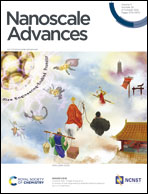Significant enhancement in quantum-dot light emitting device stability via a ZnO:polyethylenimine mixture in the electron transport layer†
Abstract
The effect of adding polyethylenimine (PEI) into the ZnO electron transport layer (ETL) of inverted quantum dot (QD) light emitting devices (QDLEDs) to form a blended ZnO:PEI ETL instead of using it in a separate layer in a bilayer ZnO/PEI ETL is investigated. Results show that while both ZnO/PEI bilayer ETL and ZnO:PEI blended ETL can improve device efficiency by more than 50% compared to QDLEDs with only ZnO, the ZnO:PEI ETL significantly improves device stability, leading to more than 10 times longer device lifetime. Investigations using devices with marking luminescent layers, electron-only devices and delayed electroluminescence measurements show that the ZnO:PEI ETL leads to a deeper penetration of electrons into the hole transport layer (HTL) of the QDLEDs. The results suggest that the stability enhancement may be due to a consequent reduction in hole accumulation at the QD/HTL interface. The findings show that ZnO:PEI ETLs can be used for enhancing both the efficiency and stability of QDLEDs. They also provide new insights into the importance of managing charge distribution in the charge transport layers for realizing high stability QDLEDs and new approaches to achieve that.



 Please wait while we load your content...
Please wait while we load your content...